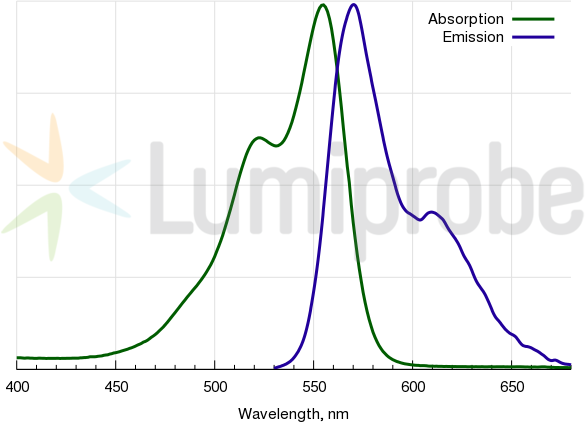Cyanine3 azide
| Cat. # | Quantity | Price | Lead time | Buy this product |
|---|---|---|---|---|
| 11030 | 100 uL, 10 mM/DMSO |
–
|
in stock | |
| 31030 | 500 uL, 10 mM/DMSO |
$199
|
in stock | |
| 41030 | 1 mL, 10 mM/DMSO |
$495
|
20 days | |
| A1030 | 1 mg |
–
|
in stock | |
| B1030 | 5 mg |
$199
|
in stock | |
| C1030 | 10 mg |
$297
|
in stock | |
| D1030 | 25 mg |
$495
|
in stock | |
| E1030 | 50 mg |
$895
|
in stock | |
| F1030 | 100 mg |
$1490
|
in stock |

Cyanine3 dye azide for сlick сhemistry, an analog of Cy3® azide. Cy3® is one of the most broadly used fluorophores which can be detected by various fluorometers, imagers, and microscopes. Due to inherently high extinction coefficient, Cyanine3 is also easily detected by naked eye on gels, and in solution. This is non-sulfonated dye which requires organic co-solvent (DMF, DMSO, or other) for efficient labeling in water. Water-soluble version of this reagent is also available.
Product is available both as solid compound, and as 10 mM solution in DMSO which is ready to use in our recommended protocol.
Cyanine3 fluorescent properties are identical to Cy3®, and similar to DyLight 549.
Cyanine3 absorbance and emission spectra

Customers also purchased with this product
General properties
| Appearance: | dark green solid or red solution |
| Molecular weight: | 575.19 |
| CAS number: | 1167421-28-4 (chloride) |
| Molecular formula: | C33H43N6OCl |
| Solubility: | soluble in organic solvents (DMF, DMSO, dichloromethane), practically insoluble in water (40 mg/L = 60 uM) |
| Quality control: | NMR 1H and HPLC-MS (95%) |
| Storage conditions: | Storage: 24 months after receival at -20°C in the dark. Transportation: at room temperature for up to 3 weeks. Avoid prolonged exposure to light. Desiccate. |
| MSDS: | Download |
| Product specifications |
Spectral properties
| Excitation/absorption maximum, nm: | 555 |
| ε, L⋅mol−1⋅cm−1: | 150000 |
| Emission maximum, nm: | 570 |
| Fluorescence quantum yield: | 0.31 |
| CF260: | 0.04 |
| CF280: | 0.09 |
Product citations
- Goedhart, J. Studentsourcing—Aggregating and reusing data from a practical cell biology course. PLOS Computational Biology, 2024, 20(2), e1011836. doi: 10.1371/journal.pcbi.1011836
- Alruwaili, M.M.; Zonneville, J.; Naranjo, M.N.; Serio, H.; Melendy, T.; Straubinger, R.M.; Gillard, B.; Foster, B.A.; Rajan, P.; Attwood, K.; Chatley, S.; Iyer, R.; Fountzilas, C.; Bakin, A.V. A synergistic two-drug therapy specifically targets a DNA repair dysregulation that occurs in p53-deficient colorectal and pancreatic cancers. Cell Reports Medicine, 2024, 5(3), 101434. doi: 10.1016/j.xcrm.2024.101434
- Liao, T.-W.; Huang, L.; Wilson, T. J.; Ganser, L. R.; Lilley, D. M. J.; Ha, T. Linking Folding Dynamics and Function of SAM/SAH Riboswitches at the Single Molecule Level. Nucleic Acids Research, 2023, 51(17), 8957–8969. doi: 10.1093/nar/gkad633
- Hernández‐Carralero, E.; Cabrera, E.; Rodríguez-Torres, G.; Hernández-Reyes, Y.; Singh, A. N.; Santa-María, C.; Fernández-Justel, J. M.; Janssens, R. C.; Marteijn, J. A.; Evert, B. O.; Mailand, N.; Gómez, M.; Ramadan, K.; Smits, V. A. J.; Freire, R. ATXN3 Controls DNA Replication and Transcription by Regulating Chromatin Structure. Nucleic Acids Research, 2023, 51(11), 5396–5413. doi: 10.1093/nar/gkad212




























 $
$ 
